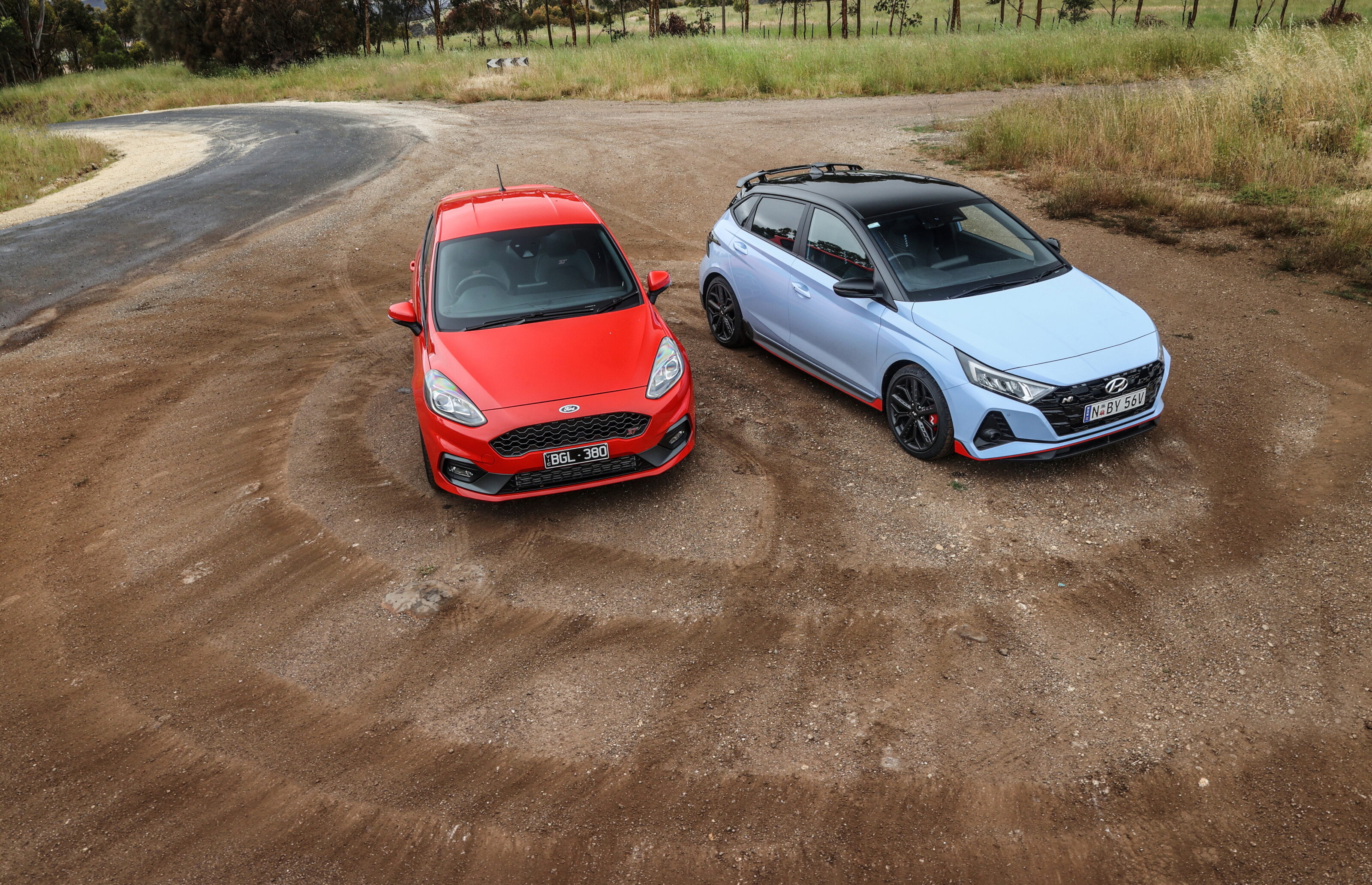Napoleon complex, small-dog syndrome, whatever you want to call it, it all means the same thing. Let’s just go with the dictionary definition: “A domineering or aggressive attitude perceived as a form of overcompensation for being physically small or short.”
Examples? How about the Ford Fiesta ST and Hyundai i20 N? No matter what you’re driving or how much power you have, on a tight, twisty road you can guarantee these little terriers will be sniffing your rear end inappropriately with headlights ablaze. But which is best?
The Fiesta ST has had a stranglehold on this segment for almost a decade. The previous generation WZ defined cheap and cheerful, effortlessly batting away challenges from the likes of the VW Polo GTI, Renault Sport Clio RS and Peugeot 208 GTi, but the current WG is even better. Quicker, more comfortable, better equipped, yet without sacrificing any of the on-limit playfulness that made its predecessor so entertaining. As a result it’s basically had the segment to itself. Until now.
Hyundai’s N Division has quickly established itself as a purveyor of fine performance cars. The original i30 N was Wheels’ favourite hot hatch and, like the Fiesta ST, its facelifted successor is an improvement in virtually every respect. Its smaller sibling, the i20, has been missing from Aussie shores for a while now, but the basic econobox we were once offered is a million miles away from this latest N version, which has its sights set firmly on stealing the Fiesta’s thunder.
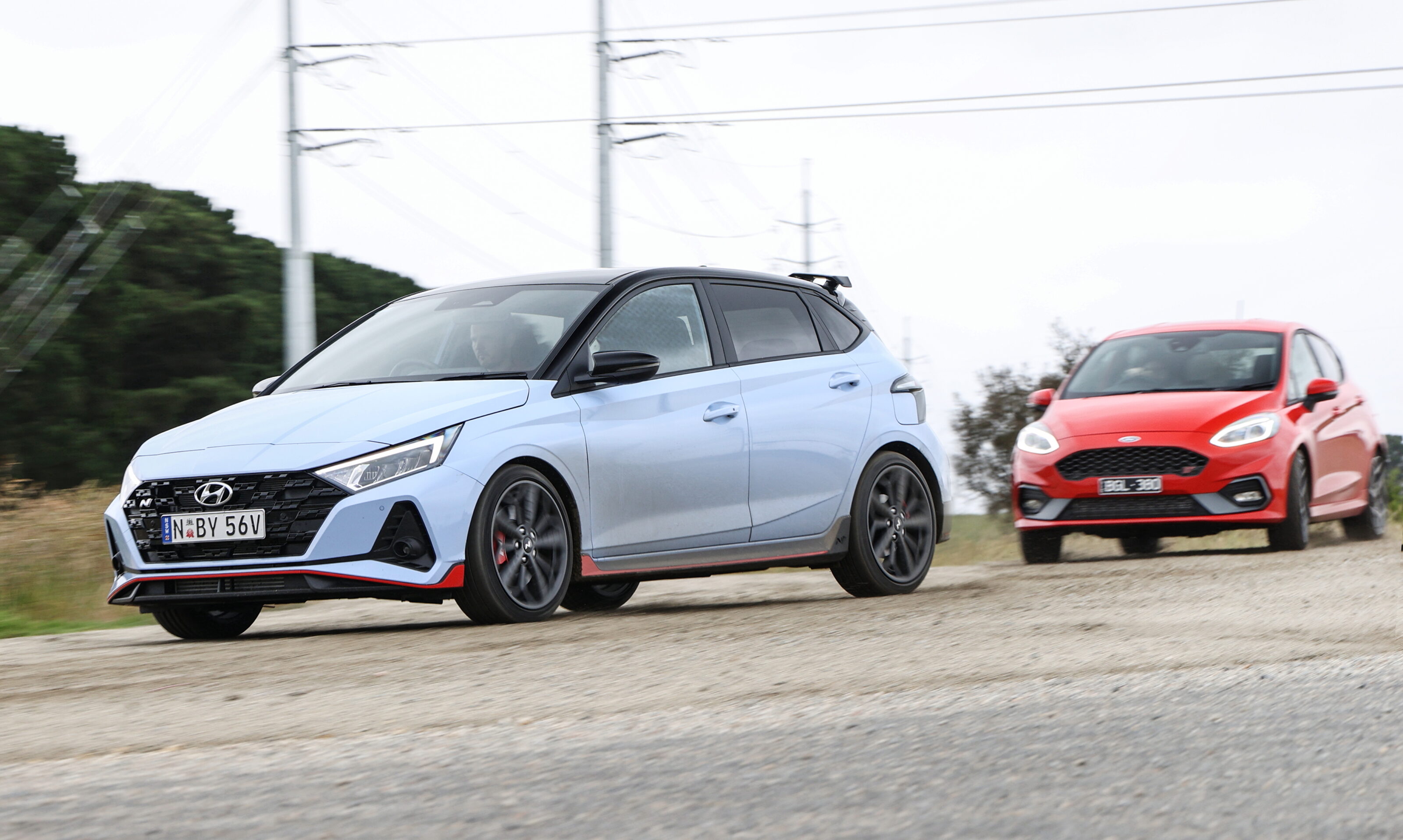
It’s virtually impossible to split the two on pricing and features. Just $200 separates the RRPs of the $32,290 Fiesta and $32,490 i20 and options are few. The Hyundai wears $1000 of two-tone roof with the only other addition being $495 for premium paint (the hero Performance Blue is standard with red or black being the fancy options).
Ford also charges an extra $650 for premium paint, though white and our test car’s red are standard, while you can also have a sunroof for $2500 if you really must. Each comes with a five-year warranty and capped-price servicing, the total cost coming in at $1520 for the i20 and $1556 for the Fiesta, though the Ford’s intervals are 12 months/15,000km versus the Hyundai’s 12 months/10,000km.
Dissecting the two cars’ specification lists is an exercise in splitting hairs. Both have keyless entry and start, touchscreen infotainment screens with smartphone mirroring, voice control, DAB+ and wireless charging, upmarket stereos (B&O in the Fiesta, Bose in the i20) and auto lights and wipers, though the Ford scores a slight win with heated seats and steering wheel.
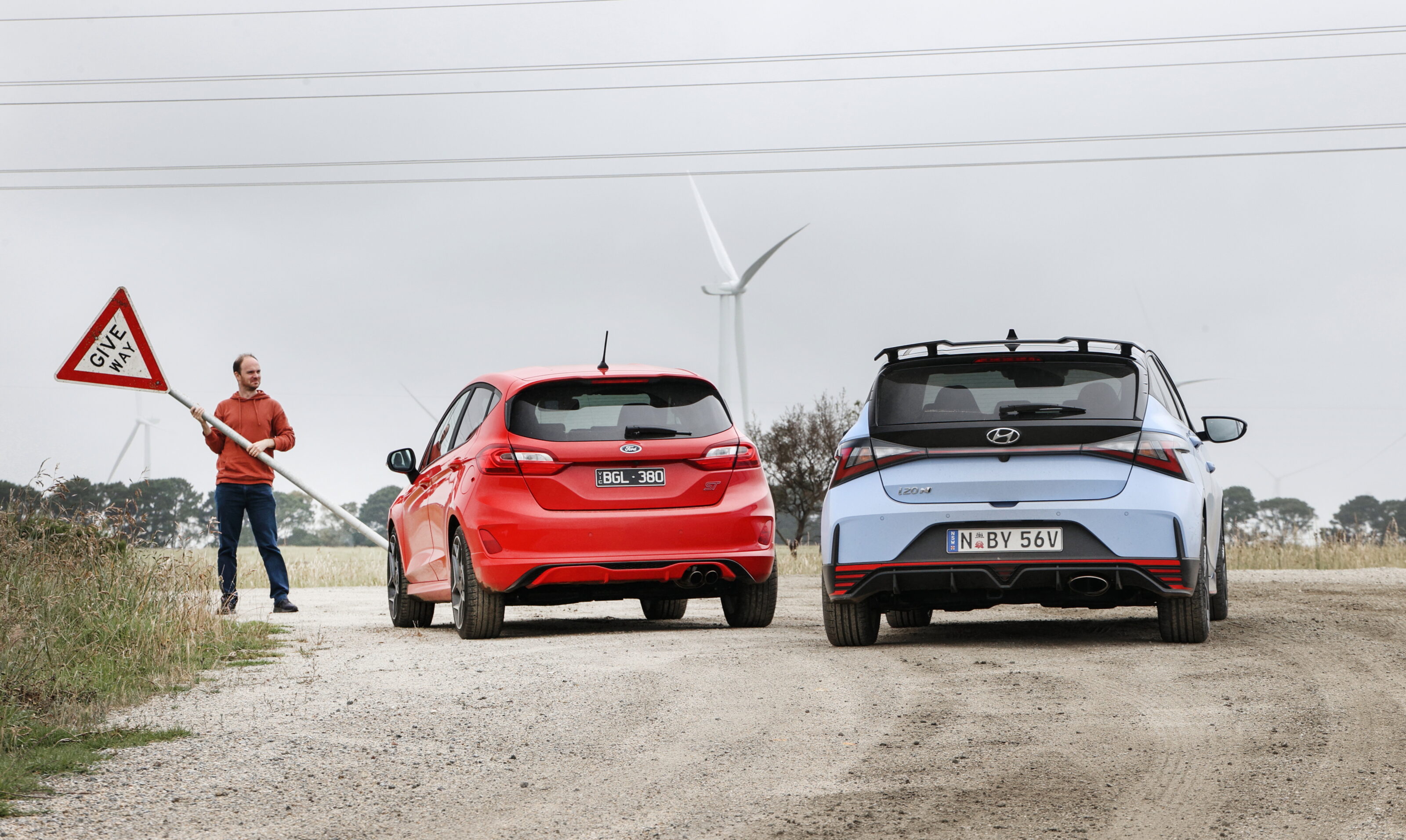
It’s equally close on a safety front, with each including AEB, blind spot warning, lane departure warning, lane keep assist, rear cross traffic alert, tyre pressure monitoring, road sign recognition, rear cameras and parking sensors. It’s tit-for-tat: the Fiesta’s AEB has cyclist as well as pedestrian detection, the i20 scores front parking sensors as well as rear.
Styling inside and out is far more likely to be the differentiator in buyers’ minds. This will come down to personal preference but it’s the Fiesta for me. The i20 is lower and squatter but extremely busy. Like the Civic Type R there’s a sense that Hyundai just couldn’t stop designing it, with slashes and layers and angles – I’ll have mine in black, please.
The Ford is taller and perhaps a little more ‘gawky’, but I prefer its curves to the Hyundai’s creases and the star rims are fantastic. You, of course, may think the complete opposite.
Inside it’s a similar story. In purely objective terms there isn’t much between them. Both have super supportive front seats and surprisingly spacious rears – two adults in the back should be no problem.
The i20 has a touch more space and its driving position is set lower, which is preferable in a performance car, but again neither one nor the other really stands out in any meaningful way beyond “I prefer the Ford’s analogue instruments’’ or “No, the Hyundai’s digital dash is way cooler”. Even their respective boot spaces are just one litre apart, the Fiesta offering 311L to the i20’s 310L.

This is all good news, as it means that this comparison verdict will have to be settled on the road. It’s a tie for the sensible stuff, so the winner will simply be the car that puts the biggest smile on the driver’s face. Not that we’re any closer to separating the two after recording straight-line acceleration figures at Heathcote Raceway, the resultant numbers leading to the befuddling conclusion that the Fiesta is faster but the i20 N is quicker. Let me explain.
Launching the traction-limited Ford is like walking a tightrope, balancing just the right amount of wheelspin, a process made more challenging by the Fiesta’s bountiful torque and very short gearing. Whereas it needs to be gently coaxed off the line at 2200rpm, the i20N takes almost double that, its front tyres spinning briefly before hooking up beautifully. Consequently, the Hyundai opens a near half-second lead by 50km/h.
The gap shrinks to just 0.2sec at 100km/h, the i20N’s 6.49sec (slower than its improbable 6.2sec claim) besting the Fiesta’s 6.7sec (again slower than Ford’s more realistic 6.5sec claim). The Hyundai’s advantage halves again at the quarter mile mark, the i20N crossing the line at 14.66sec at 152.36km/h, a fraction ahead of the Ford’s 14.76sec at 157.15km/h. Those trap speeds tell their own story, though; from 100-150km/h the Fiesta turns its 0.21sec deficit into a 0.66sec advantage.
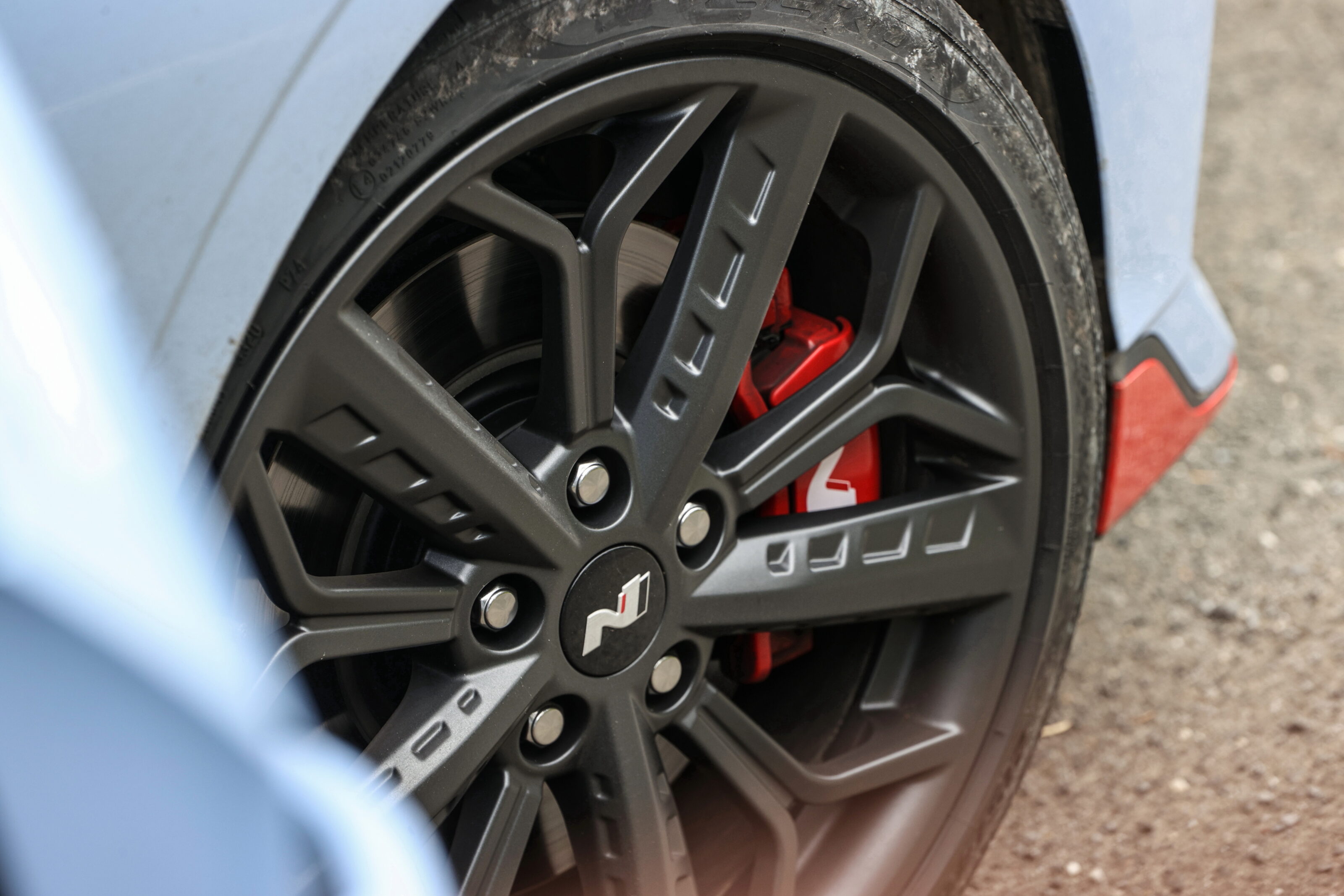
The gap shrinks to just 0.2sec at 100km/h, the i20N’s 6.49sec (slower than its improbable 6.2sec claim) besting the Fiesta’s 6.7sec (again slower than Ford’s more realistic 6.5sec claim).
Hence, while the i20N records the quicker times, once rolling there’s no question the Fiesta is the faster car. Braking turns the tables, the Hyundai pulling up in an impressive 34.32m compared to the Ford’s decidedly poor 40.49m, but we’ll return to their respective brake packages later.
On the drag strip the first stage of a pattern begins forming. These two cars are extraordinarily close in terms of outright ability, but they go about their business in an almost polar opposite fashion.
The i20 is serious, focused. Initially this makes it feel a little…dull is too strong, but reserved. Selecting Sport sharpens up the otherwise doughy throttle response but the engine is still fairly tuneless, the steering is quite weighty in the now-familiar N fashion and the suspension certainly offers plenty of control but the chassis doesn’t immediately feel like it’s keen to entertain.
Then you drive it harder. And harder. And harder still, searching for the limit of its abilities, only to discover that they are extraordinarily high. One reason the Hyundai feels slightly disinterested at slower speeds is that it’s not even close to breaking a sweat. It is phenomenally capable, the front tyres resolutely refusing to relinquish their grip on the road on corner entry and the mechanical limited-slip diff only enhancing their purchase on corner exit.
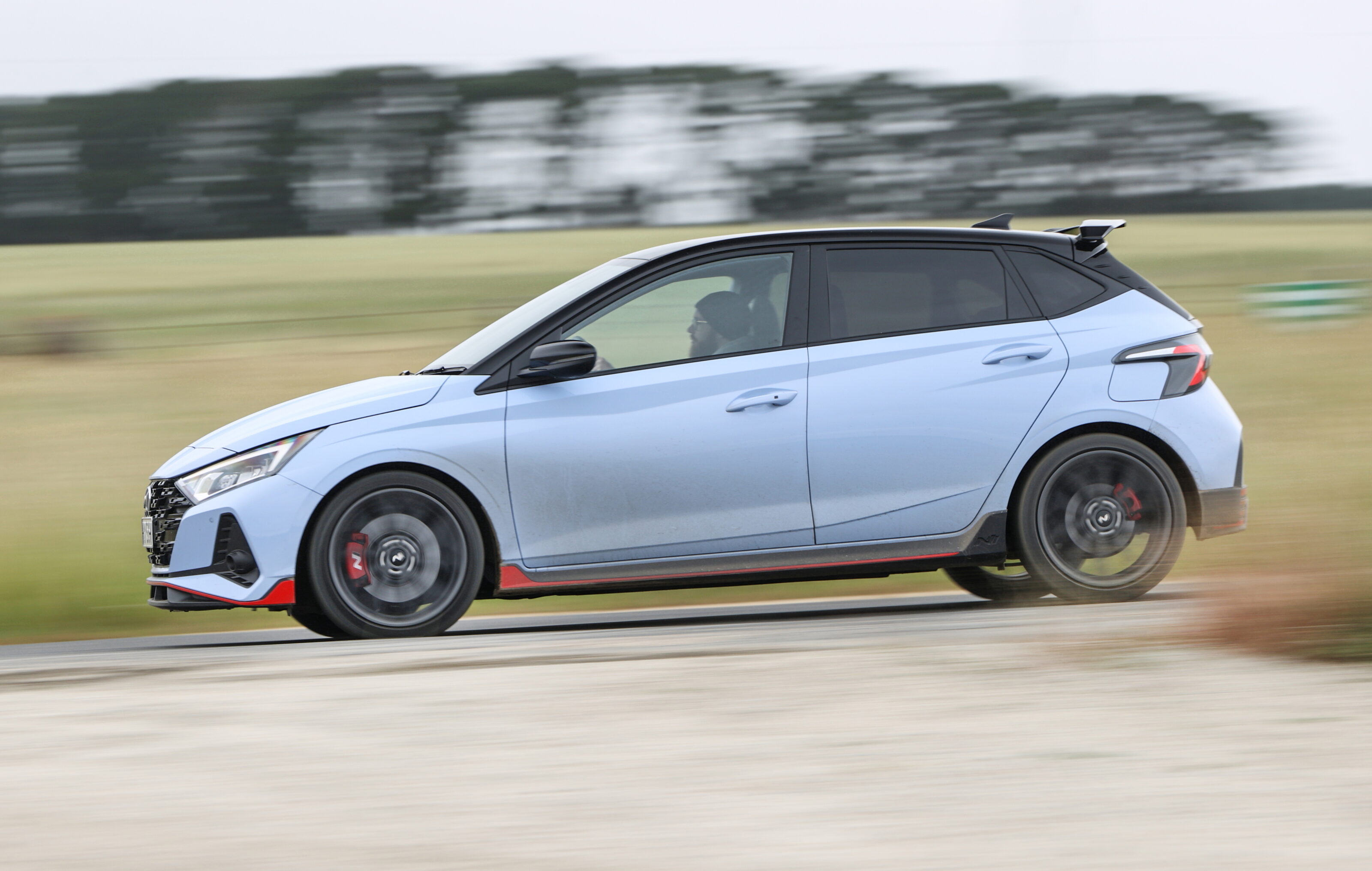
Combine this tenacity with super-strong stoppers, dampers that refuse to be beaten by bumps, a rear end that faithfully follows the front and a light, snick-snick gearshift that facilitates changes as quickly as you can move your arm and the driver is instilled with tremendous confidence.
The engine doesn’t let the side down, but nor is it operating at the same level. Boost takes a moment to build and the strong mid-range torque fades beyond 5500rpm, the shift buzzer sounding just shy of 6000rpm as a reminder that the power is running out.
Nevertheless, on a wet, narrow road pockmarked with pothole acne the i20N is fast and fun, virtually ignoring the slippery surface. The same section of road ties the Fiesta in knots.
Wheelspin, torque steer, bump steer, on-throttle understeer transitions to off-throttle oversteer; it’s a handful that requires a delicate touch, primarily due to its almost hyper-responsive chassis.
Undoubtedly, the Ford requires greater effort but there is the potential for greater reward. It moves around slightly in reaction to bumps but its clever frequency-dependent dampers beautifully soak up the road surface, though both cars rarely feel flustered no matter how big the compression. Where the Fiesta ST differs most from the i20 is the reaction to a turn of the steering wheel.
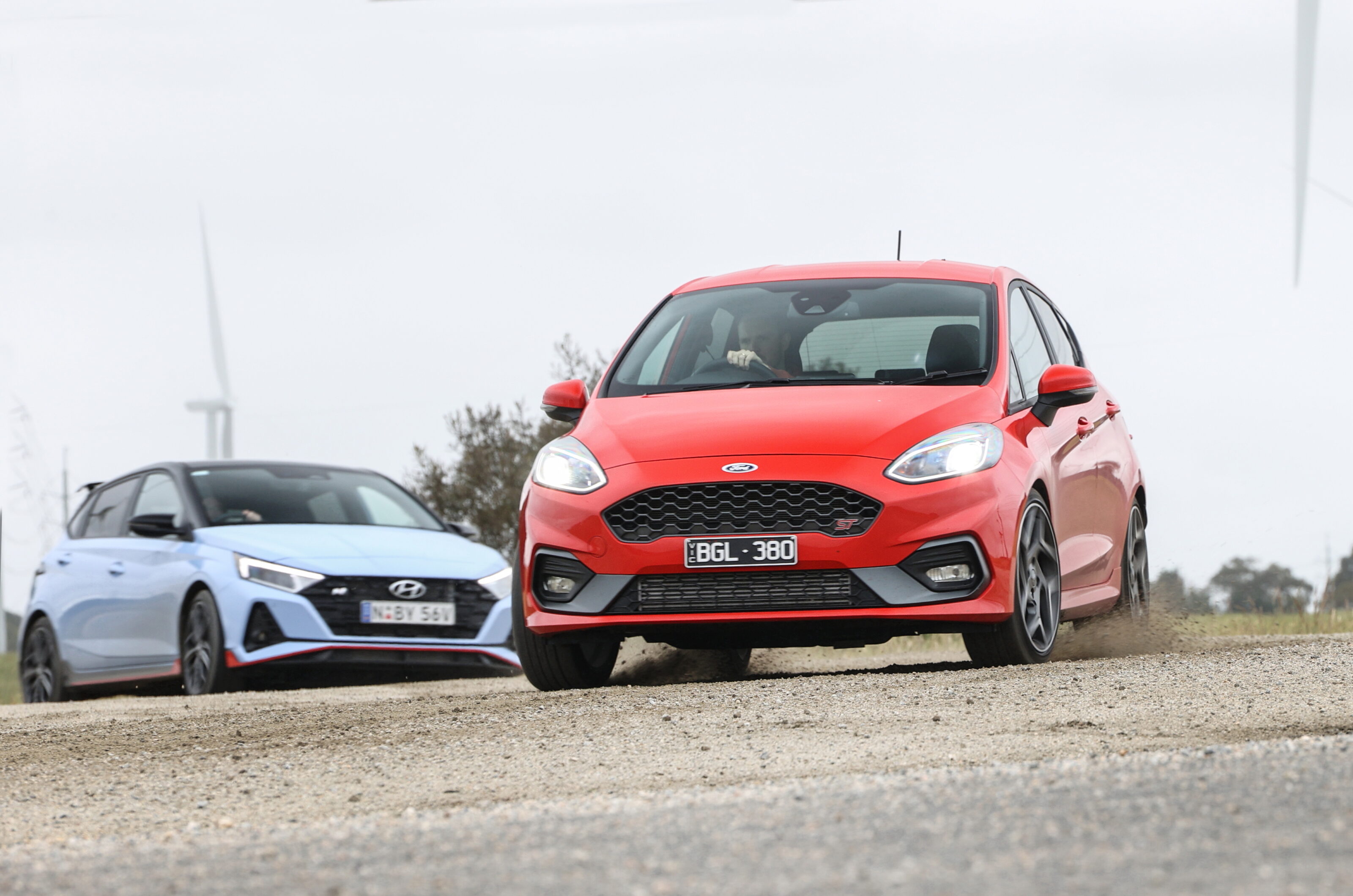
In slow corners the latter smoothly glides into the apex until the front tyres begin to gently slide wide, whereas in the former the nose is nailed to the ground and it’s the rear end that’s likely to be the one misbehaving, something the ESC Sport setting is happy to allow to a certain degree. There are shared traits, such as a predilection for waving inside rear tyres in the air and relatively weighty steering, but the details and development ethos of each is very different.
It’s most apparent in faster corners; the i20 scoots through as though it’s got ground effect aerodynamics, whereas the Fiesta always feels a bit flighty. In outright pace – in the dry at least – there is really nothing in it, but at the limit the Hyundai is certainly a calmer, more confidence inspiring place to be.
Conversely, you don’t have to be driving the ST like a maniac to be having a whale of a time, with each jink of the steering wheel or lift of the throttle eliciting a response. It needs better brakes, though, the carryover hardware from the previous generation model inadequate for the new car’s extra weight and speed.

The Ford’s attitude also makes it more engaging at slower speeds. The 1.5-litre Ecoboost triple is a thing of wonder, with instant response and a keen desire to rev right out to 6500rpm. Its bassy thrum is also much more characterful than the i20’s buzz. Ride quality is superior, though it’s a relevant assessment as either car will quickly grow wearing for anyone other than the driver. That said, the i20’s ride really is quite tough in an urban environment with an unwavering focus on body control.
So which wins? Really, we all do. Here are two cars that you can stick in your driveway for a shade over $35K and both are utterly fantastic, a pair of top-tier hot hatches that are well worth your money. Which is ultimately best depends quite a lot on what your priorities and personality are, but because no one likes a cop-out verdict the i20 comes in second by the smallest of margins. And with a caveat.
If you’re the hard-driving type, someone who loves to hit the track and is addicted to the sound and smell of smoking, ticking brakes, buy the Hyundai. It’s the superior machine for driving like your hair’s on fire. However, you have to do so for it to really come alive and to make sense of the uncompromising ride.
The Ford certainly isn’t perfect. It needs better brakes and more traction on slippery surfaces wouldn’t go astray, where it can also be a bit of a handful. But these traits are also what make it feel alive and engaging every single time you drive it. Add a fantastic engine into the mix and every journey is a joy. It might be small with an aggressive attitude, but the Fiesta ST isn’t overcompensating for anything.
The Ford’s attitude also makes it more engaging at slower speeds. The 1.5-litre Ecoboost triple is a thing of wonder, with instant response and a keen desire to rev right out to 6500rpm.
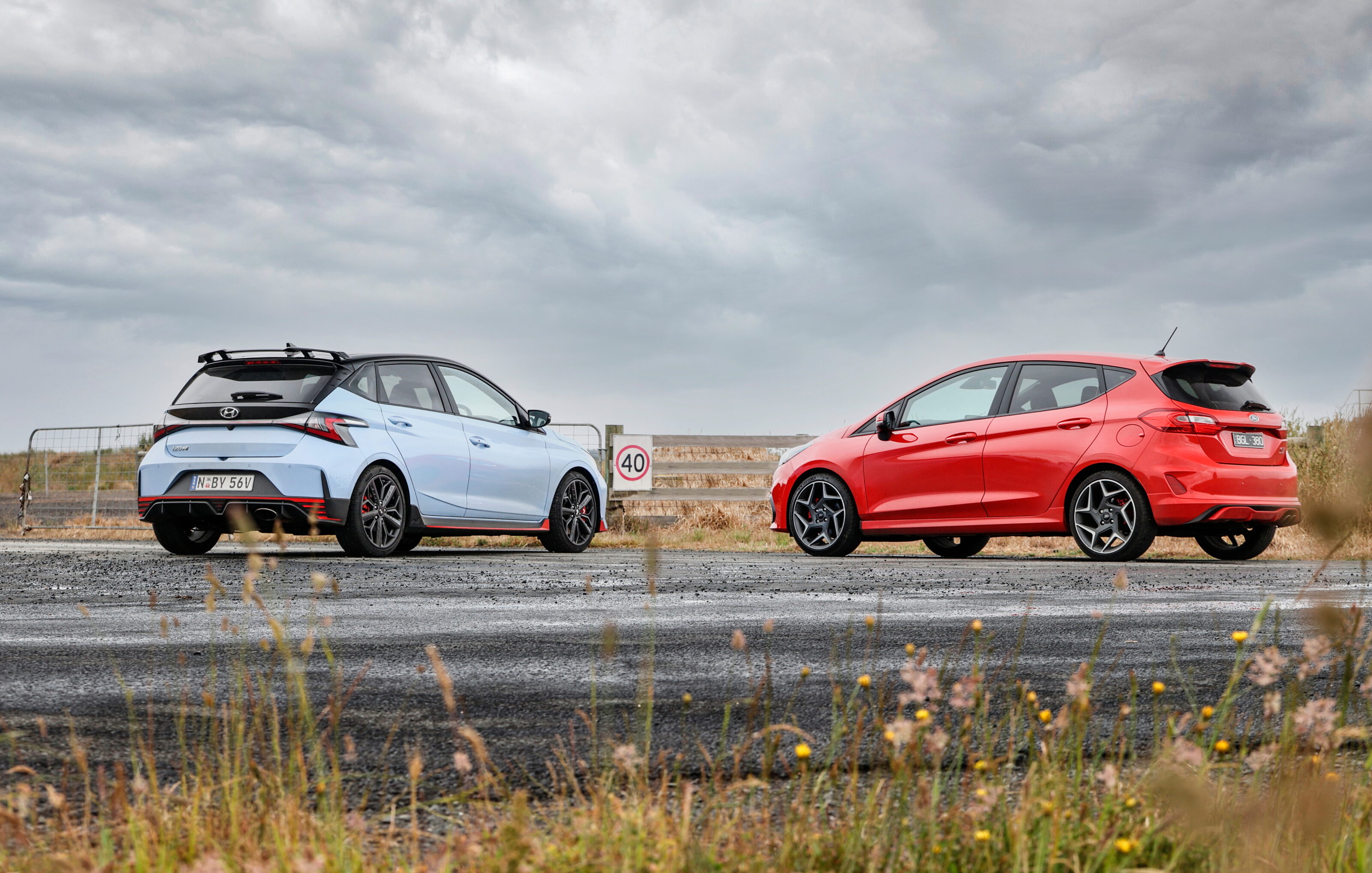
Interiors in detail
Ford Fiesta ST
Based on a car that was released in 2017, the Fiesta ST’s cabin sometimes can look half-a-generation older than the i20 N. The analogue dials are the main culprit, as well as the smaller eight-inch touchscreen.
This will change, however, when Ford updates the Fiesta ST for 2022 with a relatively huge 12.3-inch screen for the driving cluster. Its graphics will respond to the Fiesta’s relatively limited range of drive modes – spanning Normal, Sport and Race Track.
At the same time Ford will replace the pictured Recaro seats with Sensico (read: false suede) trimmed items that sport a similar chunky bucketed design.

Hyundai i20 N
The i20 N’s instruments treat you to a more technological experience. Being the newer car helps, as the i20 introduced its third generation in 2020 with a digital driving cluster to match the relatively wide 10.25-inch centre infotainment screen.
Both are capable of displaying a wealth of vehicle information, including brake pressure or throttle position. You can also change the cluster screen to a range of different designs.
Meanwhile, the steering wheel features three drive-mode buttons under its horizontal spokes. The red button activates the rev-match system, while the blue buttons are for turning on either the N1 or N2 custom-modes that store your personally selected matrix of ESC, steering and exhaust sound modes.

Second Opinion: Dylan Campbell’s take
What a hard decision. On the one hand, I love how ‘easy’ it is to go balls-to-the-wall in the i20 N, and it’s got the rare quality of getting better the harder you drive it. The Fiesta is basically opposite: the harder you drive, the more it challenges you as a driver. It’s almost a bit scary the way it’s set-up, too: lots of front grip and a nervous rear end.
But it’s exciting, and I do enjoy the riddle of how best to drive it. And I think as an ownership proposition it’d take me longer to get bored of it. Also, that three-cylinder engine is special where the i20’s four-pot is more a thing of function.
So it’s the Fiesta for me, by a whisker, but if it was a lucky dip and I got the i20 N, I wouldn’t be the slightest bit disappointed. – DC
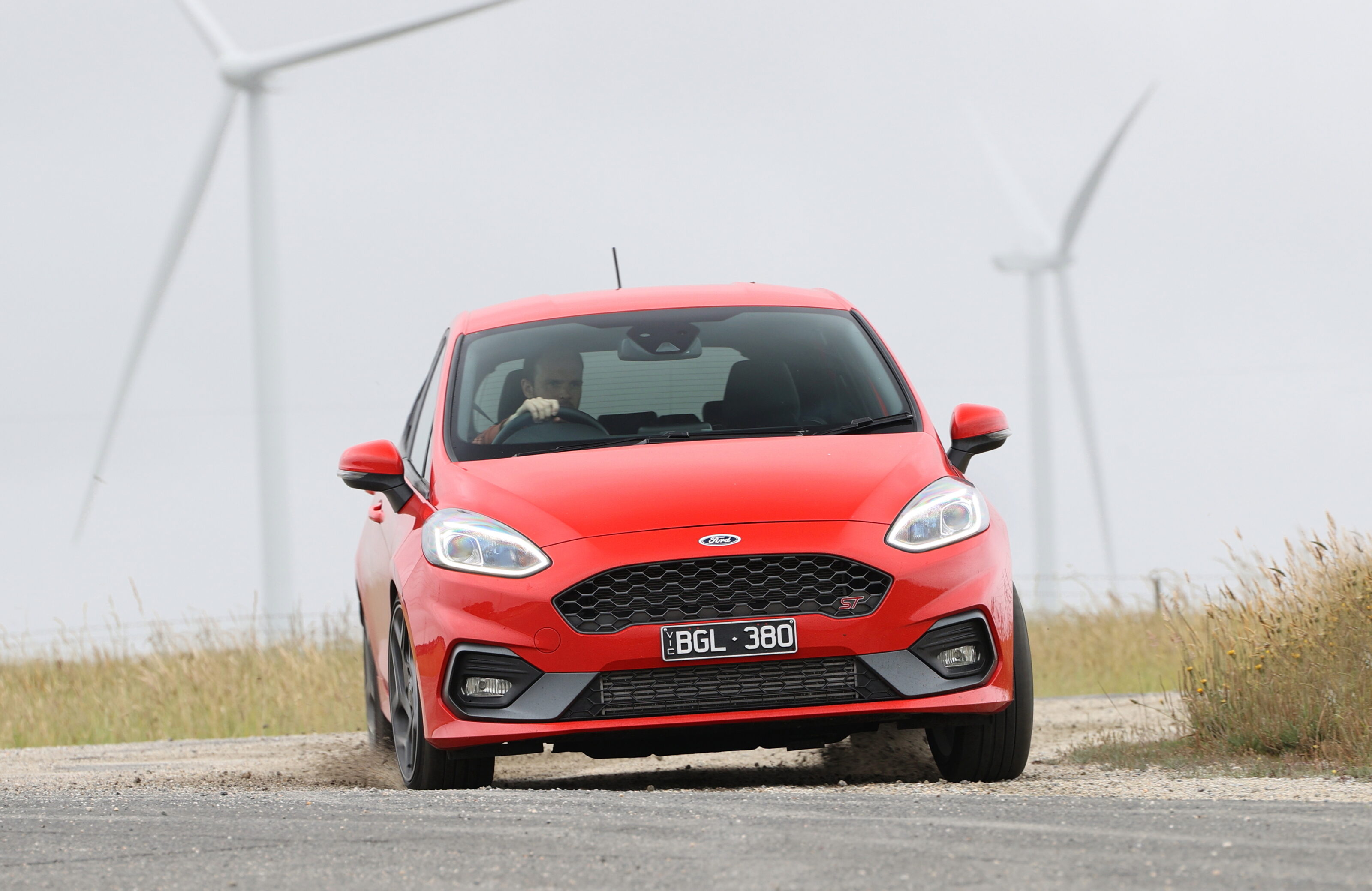
2022 Fiesta ST on the way
If you’re shopping between these two, keep in mind that a facelifted Fiesta ST is just around the corner.
While it certainly falls under the category of a ‘mild update’, there’s a styling refresh, the option of Mean Green paint (Ford’s name, not ours), new 14-way adjustable performance seats and a 30Nm torque increase to 320Nm, which should further improve its already impressive rolling acceleration.
We’ll give you the full verdict once we have seat time in the car, scheduled for Q1 2022.
Scoring
Fiesta ST: 9/10
i20 N: 9/10
2022 Ford Fiesta ST and Hyundai i20 N specifications
| u00a0 | Ford Fiesta ST | Hyundai i20N |
|---|---|---|
| u00a0 | $32,290RRP | $32,490RRP/$33,490* tested |
| u00a0 | Drivetrain | u00a0 |
| Engine | inline-3cyl, dohc, 12v, turbo | inline-4cyl, dohc, 16v, turbo |
| Layout | front-wheel | front-wheel |
| Capacity | 1497cc | 1598cc |
| u00a0Power | 147kW @ 6000rpm | 150kW @ 5500-6000rpm |
| Torque | 290Nm @ 1600-4000rpm | 275Nm @ 1750-4500rpm |
| Gearbox | 6-speed manual | 6-speed manual |
| u00a0 | Chassis | u00a0 |
| Body u00a0 | 5-door, 5-seat hatch | 5-door, 5-seat hatch |
| L/W/H/Wu2013B | 4068/1735/1469/2493mm | 4075/1775/1440/2580mm |
| Track (F/R) | 1506/1476mm (f/r) | 1544/1542mm (f/r) |
| Weight | 1218kg | 1235kg |
| Boot | 311L | 310L |
| Fuel/tank | petrol/45 litres | petrol/40 litres |
| Economy | 6.3L/100km (ADR combined cycle) | 6.9L/100km (ADR combined cycle) |
| Suspension u00a0 u00a0 u00a0 | Struts, coil springs, anti-roll bar (f); torsion beam, coil springs (r) | Struts, coil springs, anti-roll bar (f); torsion beam, coil springs (r) |
| Steering u00a0 | electric rack-and-pinion | electric rack-and-pinion |
| Front brakes u00a0 | 278mm ventilated discs, single-piston calipers | 320mm ventilated discs, single-piston calipers |
| Rear brakes | 253mm solid discs, single-piston calipers (r) u00a0 | 262mm solid discs, single-piston calipers (r) |
| Tyres u00a0 | Michelin Pilot Sport 4 | Pirelli P Zero HN |
| Tyre size | 205/40 ZR18 (f/r) | 215/40 R18 (f/r) |
| u00a0 | Safety | u00a0 |
| ANCAP rating | 5 stars 5 stars | 5 stars |
| Verdict | 9.0/10 | 9.0/10 |
| u00a0 | Warranty: 5ys/unlimited km Service interval: 12 months/15,000km Glassu2019s 3-year resale: NA AAMI insurance: $856 | Warranty: 5ys/unlimited km Service interval: 12 months/10,000km Glassu2019s 3-year resale: NA AAMI insurance: $857 *Prestige paint u2013 two-tone roof $1000 |
We recommend
-
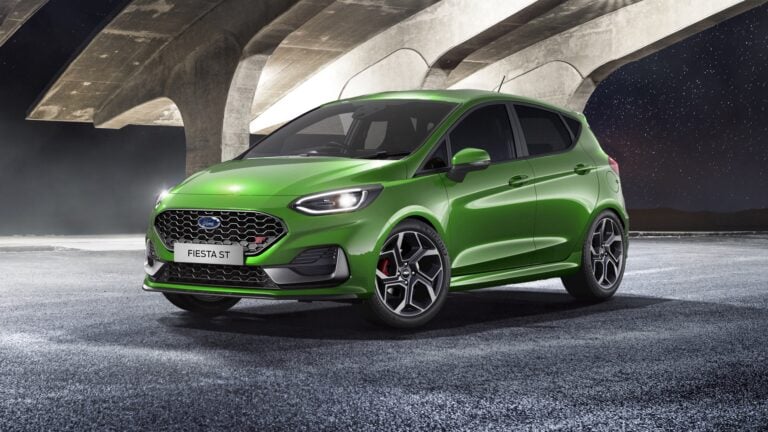 News
News2022 Ford Fiesta ST pricing and features for Australia
Range of minor updates for the hot Fiesta comes at a $1200 premium over outgoing model
-
 Reviews
Reviews2021 Ford Fiesta ST review
The new Fiesta ST has taken its sweet time getting to Australia, but all good things come to those who wait
-
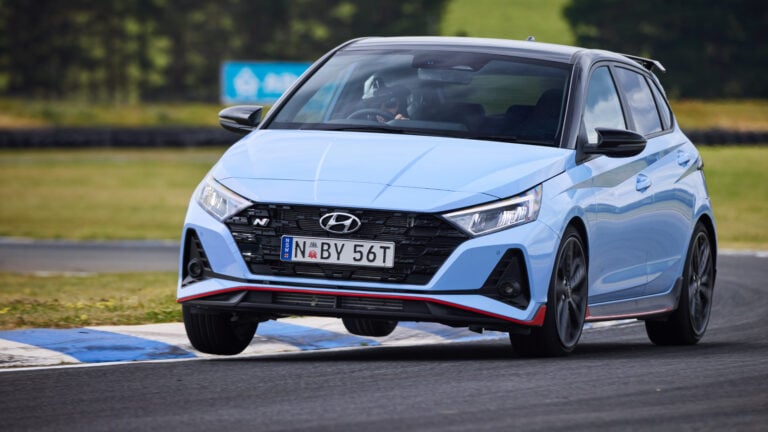 Reviews
Reviews2022 Hyundai i20 N tested on road and track
Hyundai’s newest N Division production is all about fun for fun’s sake


